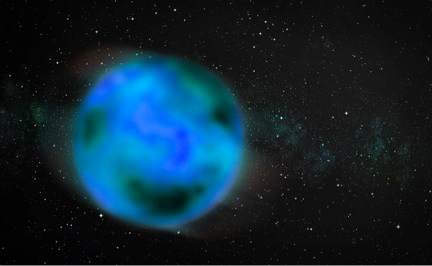Nomad Alien Planets May Fill Our Milky Way Galaxy

Our Milky Way galaxy may be teeming with rogue planets that ramble through space instead of being locked in orbit around a star, a new study suggests.
These "nomad planets" could be surprisingly common in our bustling galaxy, according to researchers at the Kavli Institute for Particle Astrophysics and Cosmology (KIPAC), a joint institute of Stanford University and the SLAC National Accelerator Laboratory. The study predicts that there may be 100,000 times more of these wandering, homeless planets than stars in the Milky Way.
If this is the case, these intriguing cosmic bodies would belong to a whole new class of alien worlds, shaking up existing theories of planet formation. These free-flying planets may also raise new and tantalizing questions in the search for life beyond Earth.
"If any of these nomad planets are big enough to have a thick atmosphere, they could have trapped enough heat for bacterial life to exist," study leader Louis Strigari said in a statement.
And while nomad planets cannot benefit from the heat given off from their parent stars, these worlds could generate heat from tectonic activity or internal radioactive decay, the researchers said.
For now, characteristics of these foreign objects are still unknown; they could be icy bodies, similar to other objects found in the outer solar system, rocky like asteroids, or gas giants similar to the most massive planets in our solar system. [Gallery: First Earth-Size Alien Planets Found]
Over the past several decades, astronomers have keenly hunted for planets outside our solar system. So far, the search has turned up more than 700 of these exoplanets. Almost all of these newfound worlds orbit stars, but last year, scientists found about a dozen planets with no discernible host star.
Breaking space news, the latest updates on rocket launches, skywatching events and more!
The researchers used a technique called gravitational microlensing to detect these homeless planets. This method examines the effects of a massive object passing in front of a star.
From Earth, the nearby object bends and magnifies the light from the distant star like a lens, making the faraway star's light appear to brighten and fade over time. The resulting "light curve" helps astronomers distinguish characteristics of the foreground object.
Based on initial estimates, approximately two free-flying planets exist for every "normal" star in our galaxy, but the results of the new study produced even more staggering findings: nomad planets may be up to 50,000 times more common than that.
"To paraphrase Dorothy from 'The Wizard of Oz,' if correct, this extrapolation implies that we are not in Kansas anymore, and in fact we never were in Kansas," Alan Boss, of the Carnegie Institution for Science in Washington, D.C., said in a statement. "The universe is riddled with unseen planetary-mass objects that we are just now able to detect."
The KIPAC researchers made their prediction by calculating the known gravitational pull of the Milky Way, the amount of matter available in the galaxy to make such celestial objects, and how that matter might be distributed to make up objects that range from as small as Pluto to as large as Jupiter.
These measurements were challenging since astronomers are unsure where these wandering planets came from, the researchers said. Some of these rogue worlds were likely ejected from other star systems, but there is evidence that not all of them could have been formed this way, Strigari said.
The researchers are hopeful that follow-up observations using next generation telescopes, particularly of the smaller objects, will yield more detailed results. The planned space-based Wide Field Infrared Survey Telescope, and the Large Synoptic Survey Telescope on the ground, are both set to begin operations in the early 2020s.
If the estimated number of these nomad planets is correct, the results could lead to exciting prospects about the origin and abundance of life in our Milky Way galaxy. For instance, as these homeless planets mosey through space, collisions could break apart pieces of these rogue worlds and fling bacterial life onto other celestial bodies, the researchers said.
"Few areas of science have excited as much popular and professional interest in recent times as the prevalence of life in the universe," study co-author Roger Blandford, director of KIPAC, said in a statement. "What is wonderful is that we can now start to address this question quantitatively by seeking more of these erstwhile planets and asteroids wandering through interstellar space, and then speculate about hitchhiking bugs."
Details of the study are published in the Monthly Notices of the Royal Astronomical Society.
Follow SPACE.com for the latest in space science and exploration news on Twitter @Spacedotcom and on Facebook.

Space.com is the premier source of space exploration, innovation and astronomy news, chronicling (and celebrating) humanity's ongoing expansion across the final frontier. Originally founded in 1999, Space.com is, and always has been, the passion of writers and editors who are space fans and also trained journalists. Our current news team consists of Editor-in-Chief Tariq Malik; Editor Hanneke Weitering, Senior Space Writer Mike Wall; Senior Writer Meghan Bartels; Senior Writer Chelsea Gohd, Senior Writer Tereza Pultarova and Staff Writer Alexander Cox, focusing on e-commerce. Senior Producer Steve Spaleta oversees our space videos, with Diana Whitcroft as our Social Media Editor.
